Just like outdoor gardening, growing plants indoors involves a lot of patience. Sometimes it’s literally slower than watching grass grow if you have a lot of sluggish plants like Anubias.
If you’re looking for something that fills in faster though, don’t worry. So long as you can fuel them with enough light, there are plenty of fast growing aquarium plants to consider!
Top 10 Fast Growing Aquarium Plants
Here are 10 of the fastest growing aquarium plants you can find:
Duckweed
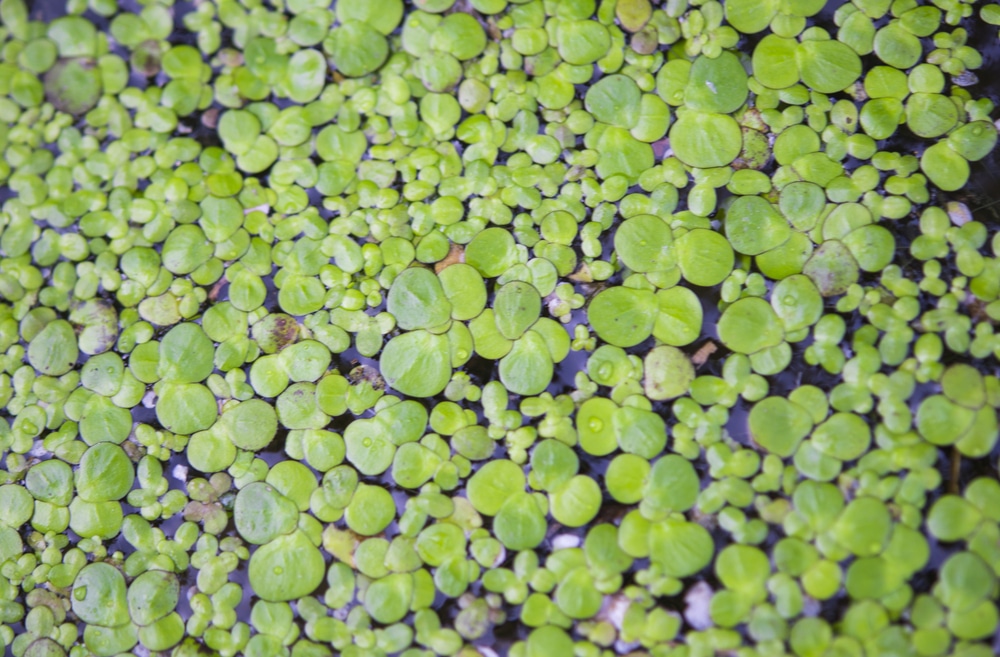
From Betta to Turtle tanks, Duckweed is one of the most versatile plants in the hobby. And as you may already know, one of the most problematic!
All plants need light and carbon dioxide to fuel photosynthesis, their ability to make sugars for their metabolism. Duckweed has a major advantage over other aquatic plants. By sitting right at the surface they can maximize their intake of both of these essential plant nutrients.
Duckweed doesn’t grow wasteful structures like stems or roots. They simply divide explosively, covering the surface of a body of water in just days if there’s no current to sweep them away.
Even in aquariums without full-spectrum plant lighting Duckweed can thrive. Especially since tanks with fish have high nutrient levels for plants. You’ll likely need to scoop out handfuls of Duckweed weekly to keep it from overwhelming the surface.
However if the plants underneath can tolerate low lighting conditions and your filtration isn’t being affected…A Duckweed blanket creates a gorgeous natural pond look!
- Scientific Name: family Lemnoideae
- Origin: Worldwide
- Height: floating plant
- Light Requirements: High
- Nutritional Needs: Low
- Ease of Care: Very Easy
Pygmy Chain Sword Plant
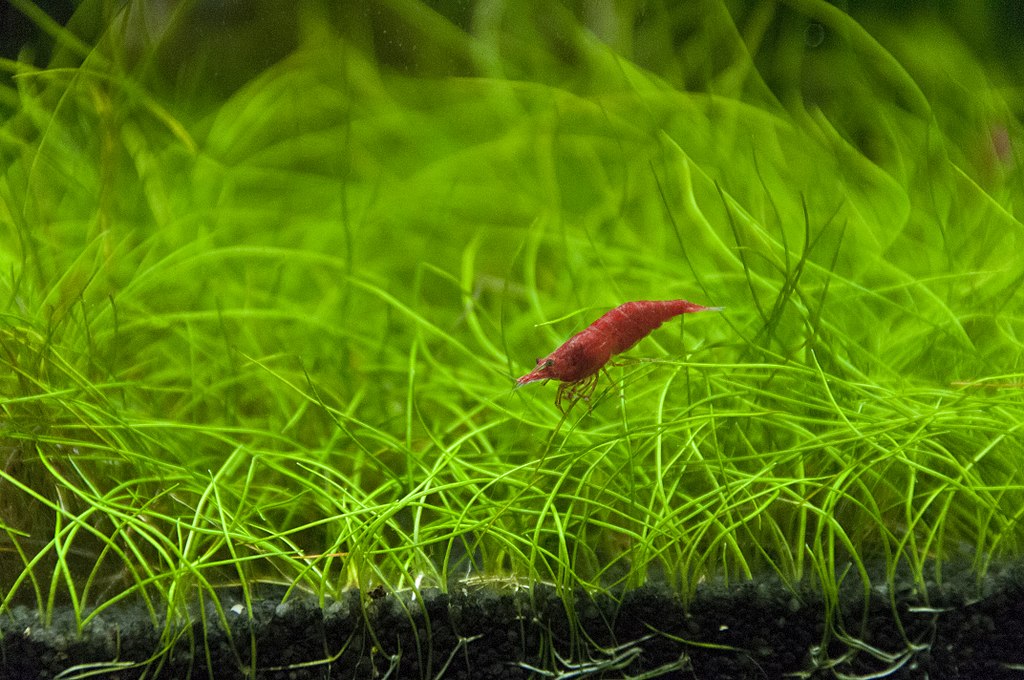
This plant was formerly described as Echinodorus tenellus, placing it in the same genus as the popular Amazon Sword Plant (Echinodorus sp.). However this micro relative has been shifted over to its own genus of Helanthium.
That said, it’s very similar to its Amazonian cousins in terms of care. Being a dwarf variety, extra care should be given to light levels near the substrate because this plant is as hungry as any other Sword Plant.
Moderate to high lighting and a rich planting substrate will ensure it not only fills in but sends runners throughout the substrate. It’s a bit too tall to be considered a proper carpeting plant.
However it does create a nice grassy appearance, especially in high light aquariums where it stays compact! Some varieties even show a bit of red coloring when given loads of light!
- Scientific Name: Helanthium tenellum
- Origin: North & South America
- Height: 3-4 inches
- Light Requirements: Moderate
- Nutritional Needs: Moderate
- Ease of Care: Easy
Giant Hygrophila
Hygrophila as a group are often known as “swamp weed,” which describes their habitat perfectly. Slow moving or still waters that are hot and rich in plant nutrients are where you’ll find Giant Hygro in abundance.
These plants are some of the easiest stem plants to grow and even do fairly well in low light environments. However the more light and nutrients you give them the faster they will soak them up. You’ll likely need to give your Giant HYdro a weekly trim in ideal conditions!
The bright green leaves can grow 4-6 inches long and take up loads of space. That makes the Giant Hygro an ideal show or background plant for larger aquariums (55+ gallons).
In smaller tanks it will usually shade and overwhelm smaller plants. Its size and growth rate make it perfect for tanks with fish that are hard on plants, such as Cichlids!
- Scientific Name: Hygrophila corymbosa
- Origin: Southeast Asia
- Height: Up to 24 inches
- Light Requirements: Moderate
- Nutritional Needs: Moderate
- Ease of Care: Easy
Water Wisteria
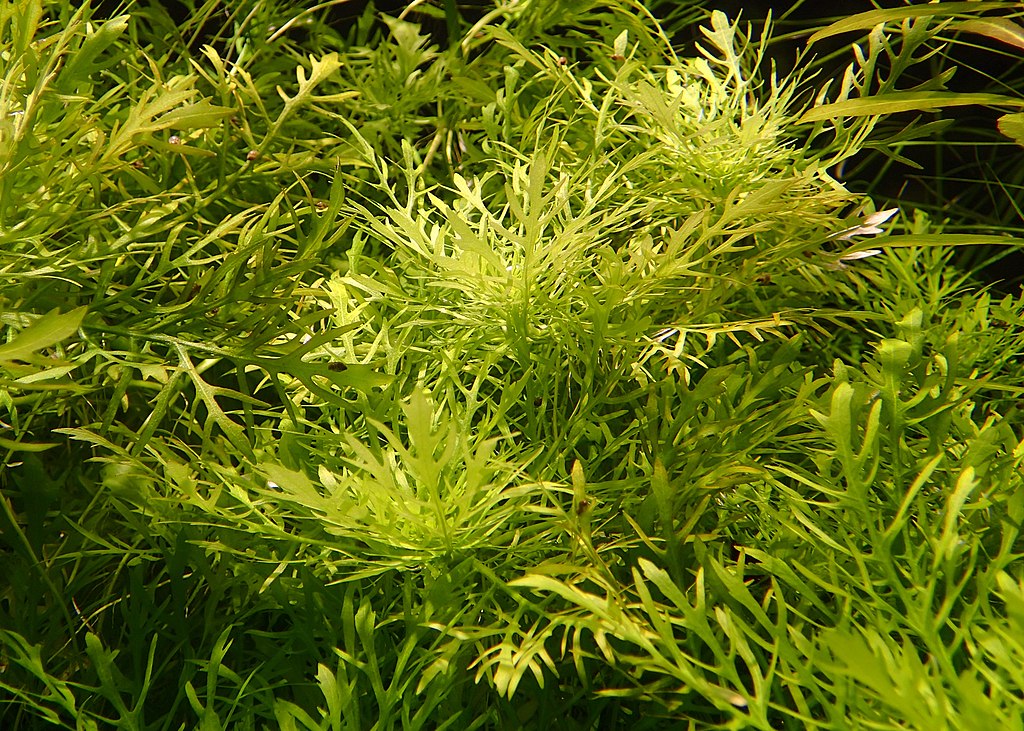
Water Wisteria is another Hygrophila species, which clues you into how to care for it: as much light and fertilizer as you can give it. And keep the pruning scissors nearby because this species loves to sprawl outwards, especially after being cut back!
Water Wisteria responds well to carbon dioxide and fertilization, often visibly getting taller and fuller by the day. It makes a great nutrient sponge, locking away nitrates and other chemicals that cause your fish harm when allowed to build up.
It also has an intriguing growth habit; when kept in low light environments it has rounded, normal looking dark green leaves. But in moderate to high lighting it takes on a light green tone with beautiful, wide, forked leaves that make it a great background or center stage plant!
- Scientific Name: Hygrophila difformis
- Origin: Southeast Asia
- Height: 14 inches
- Light Requirements: Low to High
- Nutritional Needs: Moderate
- Ease of Care: Easy
Hornwort
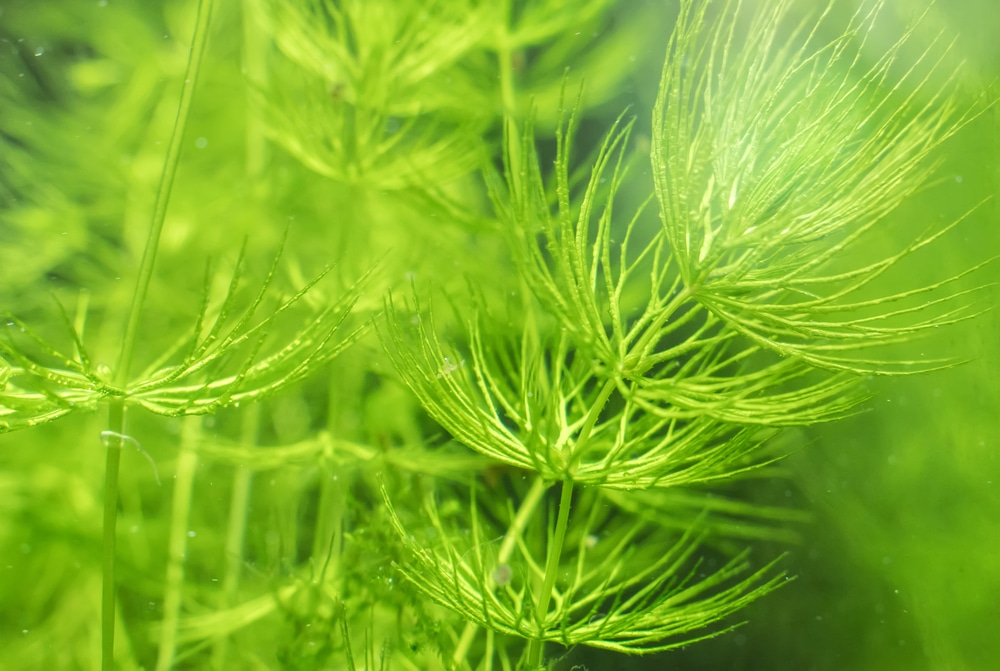
Hornwort is an aquarium and pond staple for very good reason. All you need to do is just toss it in the water and walk away. Seriously.
You may not be able to find Hornwort in some states or countries because it’s too easy to grow. It has a tendency to overwhelm native vegetation if the local animals don’t develop a taste for it.
It thrives in temperatures ranging from 60-85℉ and in all water chemistries. Hornwort can be grown as a substrate rooter or as a floating plant, where it forms dense tangles of bristly leaves.
Young fish and shrimp find Hornwort especially attractive as a place to feed and hide until they reach maturity!
- Scientific Name: Ceratophyllum demersum
- Origin: Worldwide
- Height: 3-5 feet or floating
- Light Requirements: High
- Nutritional Needs: Moderate
- Ease of Care: Easy
Brazilian Pennywort
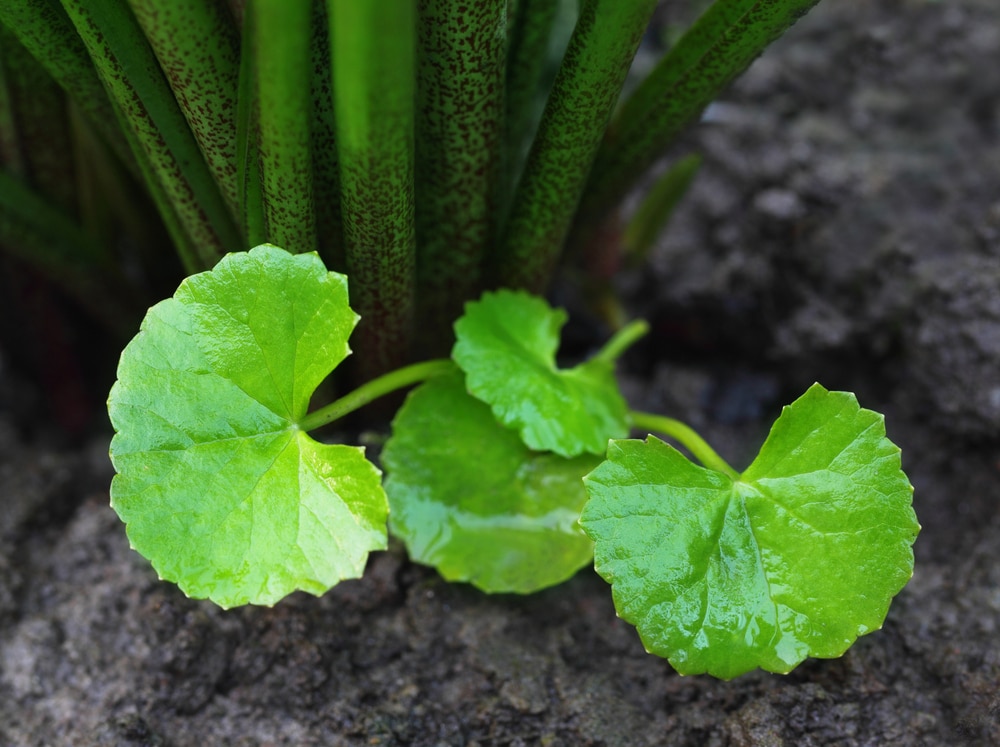
Brazilian Pennywort is as versatile as Hornwort but looks much nicer thanks to its unusual saucer-shaped leaves. It can also be grown emersed or partially submerged, making it a perfect plant for a paludarium or terrarium!
Not only are the leaves unique but the jointed stems create an almost fantasy appearance. At each joint roots sprout that seek out rocks or substrate to dig into, securing the plant in place.
While it can be grown in lower lighting and nutrient levels it needs at least moderate full spectrum light and some fertilizer to really take off. Carbon dioxide isn’t needed but helps fuel even more rapid growth!
- Scientific Name: Hydrocotyle leucocephala
- Origin: Central & South America
- Height: 14 inches
- Light Requirements: Moderate
- Nutritional Needs: Moderate
- Ease of Care: Easy
Amazon Sword Plant
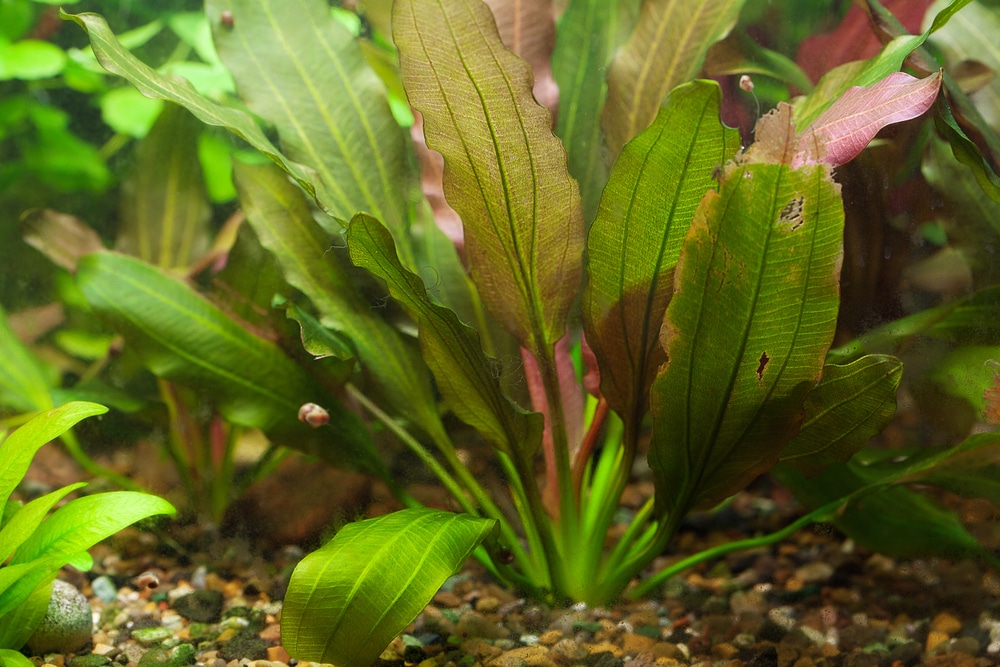
Amazon Sword Plants are an aquarium staple. There are a few species but all are medium to extra large in size. They are typically grown as show plants for Discus, Angelfish, and medium to large planted aquascapes.
They are very hungry plants that especially love iron enrichment and prefer to feed from their roots rather than the water column. However they are incredibly easy to grow, so long as you attend to their needs: plenty of light, no crowding, and fertile ground.
Many varieties also come in red, adding a unique hue to the center or midground!
- Scientific Name: Echinodorus sp.
- Origin: Amazon basin
- Height: 8-18 inches
- Light Requirements: Moderate
- Nutritional Needs: High
- Ease of Care: Easy
Anacharis
This is one of the least expensive and most popular fast growing aquarium plants in the hobby! Originally from Brazil, this plant is capable of doing well even in colder temperatures. It prefers water temperatures of 60-75℉ and moderate chemistry (pH 6.5-7.5).
Anacharis has a fluffy seaweed-like appearance and dark green color when healthy. Combined with its bargain price, it’s often a new aquarist’s first plant!
But be careful when choosing your fish! Anacharis grows quickly but has soft, delicious leaves. Goldfish, Barbs, Silver Dollars, and other vegetarians may eat it down to nothing if given the chance.
- Scientific Name: Elodea densa
- Origin: Brazil
- Height: 8-12 inches
- Light Requirements: Moderate
- Nutritional Needs: Moderate
- Ease of Care: Moderate
Java Moss
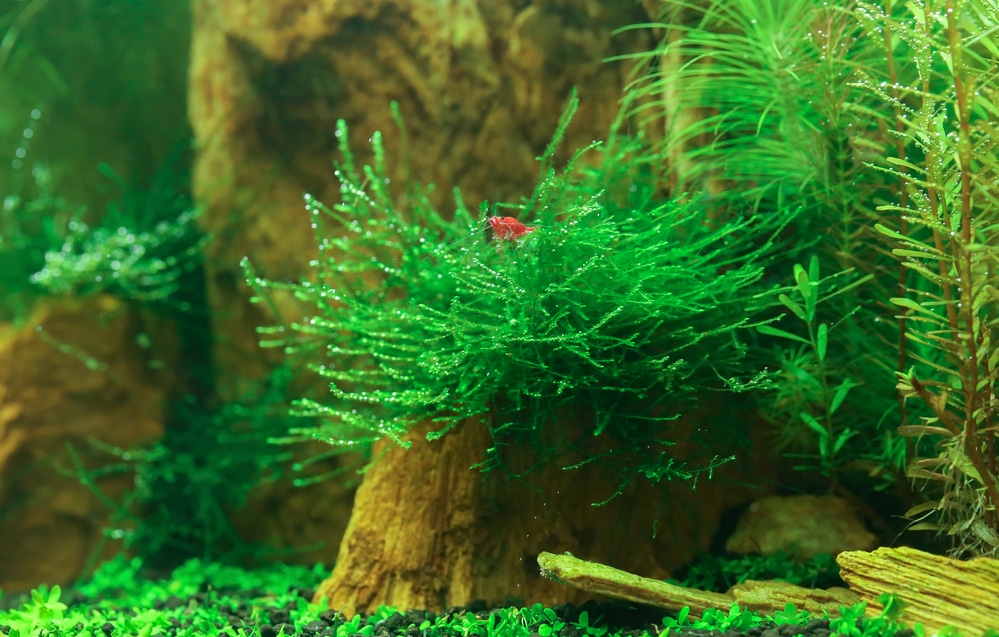
Java Moss is another set and forget plant. In this case, it’s better to secure it to driftwood or rocks until it fully attaches. If left floating it will still grow but forms very messy tangles that take up the entire aquarium!
It’s extremely easy to grow, not even needing (but still appreciating) full spectrum light, carbon dioxide, or fertilizer. It forms thick tufts of green wherever it’s planted. It has several close relatives as well that grow slower but are much tidier in appearance, including Flame and Christmas Moss.
Java Moss is an excellent spawning bed for egg scatters like Danios and livebearing fish like Guppies as well. The eggs and fry have a much better chance of avoiding predators until they are large enough to live alongside their parents.
- Scientific Name: Vesicularia Dubyana
- Origin: Indonesia
- Height: 4 inches
- Light Requirements: Low
- Nutritional Needs: Low
- Ease of Care: Very Easy
HC Cuba
Carpeting plants as a whole are some of the most challenging plants to care for. Since they are so far down in the water column, it takes intense light to keep them happy.
HC Cuba is very needy but is a very fast growing aquarium plant if you have some experience with carpeting types. It absolutely must have injected carbon dioxide, intense full spectrum lighting, and fertilization or it will simply die. When choosing your substrate you’ll need something that’s finely powdered yet enriched so nutrients go right to the roots!
HC Cuba grows millimeter sized bright green leaves that will cover the bottom in a look that’s not quite mossy or grassy. It’s the hallmark of the professional aquascaper’s talents to have a full carpet of HC Cuba!
- Scientific Name: Alternanthera reineckii
- Origin: Cuba
- Height: ½-1 inch (carpeting)
- Light Requirements: High
- Nutritional Needs: Moderate
- Ease of Care: Difficult

